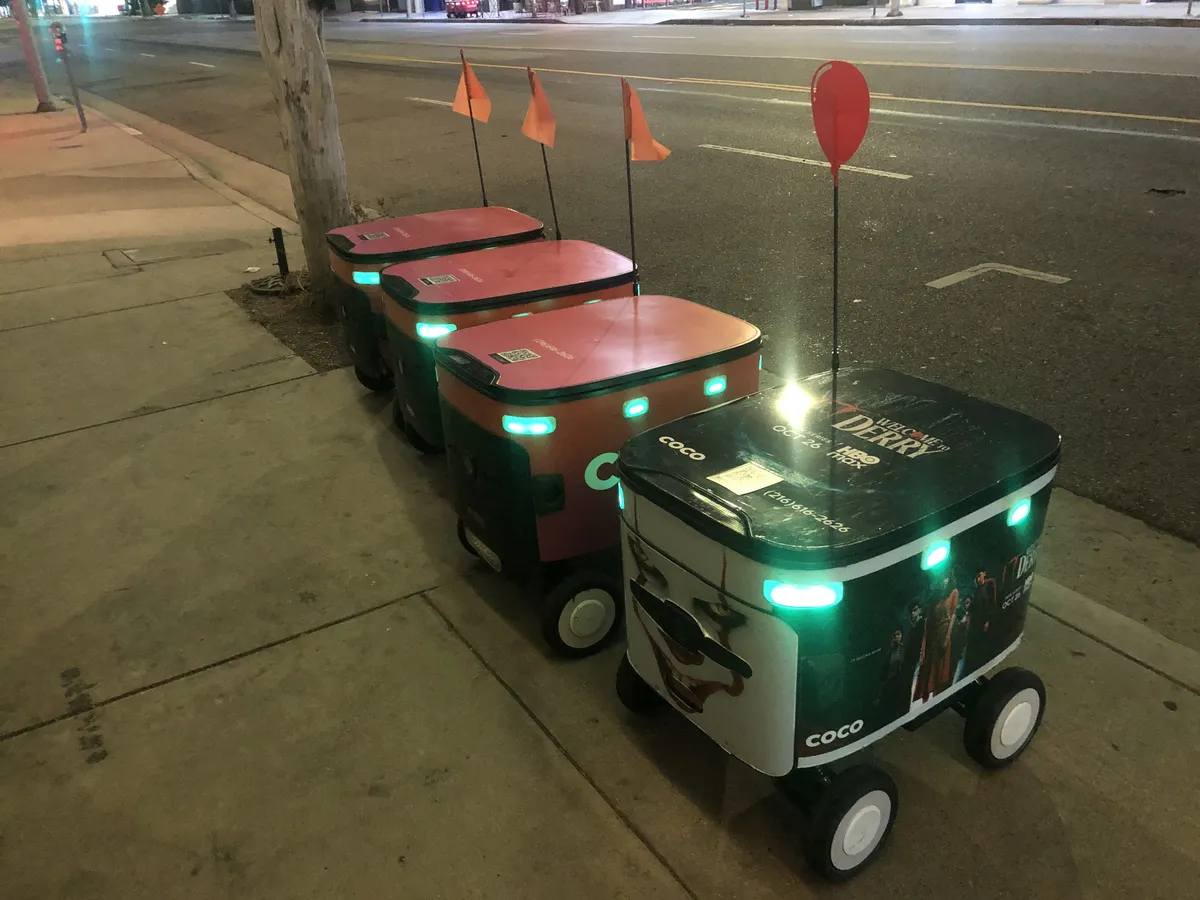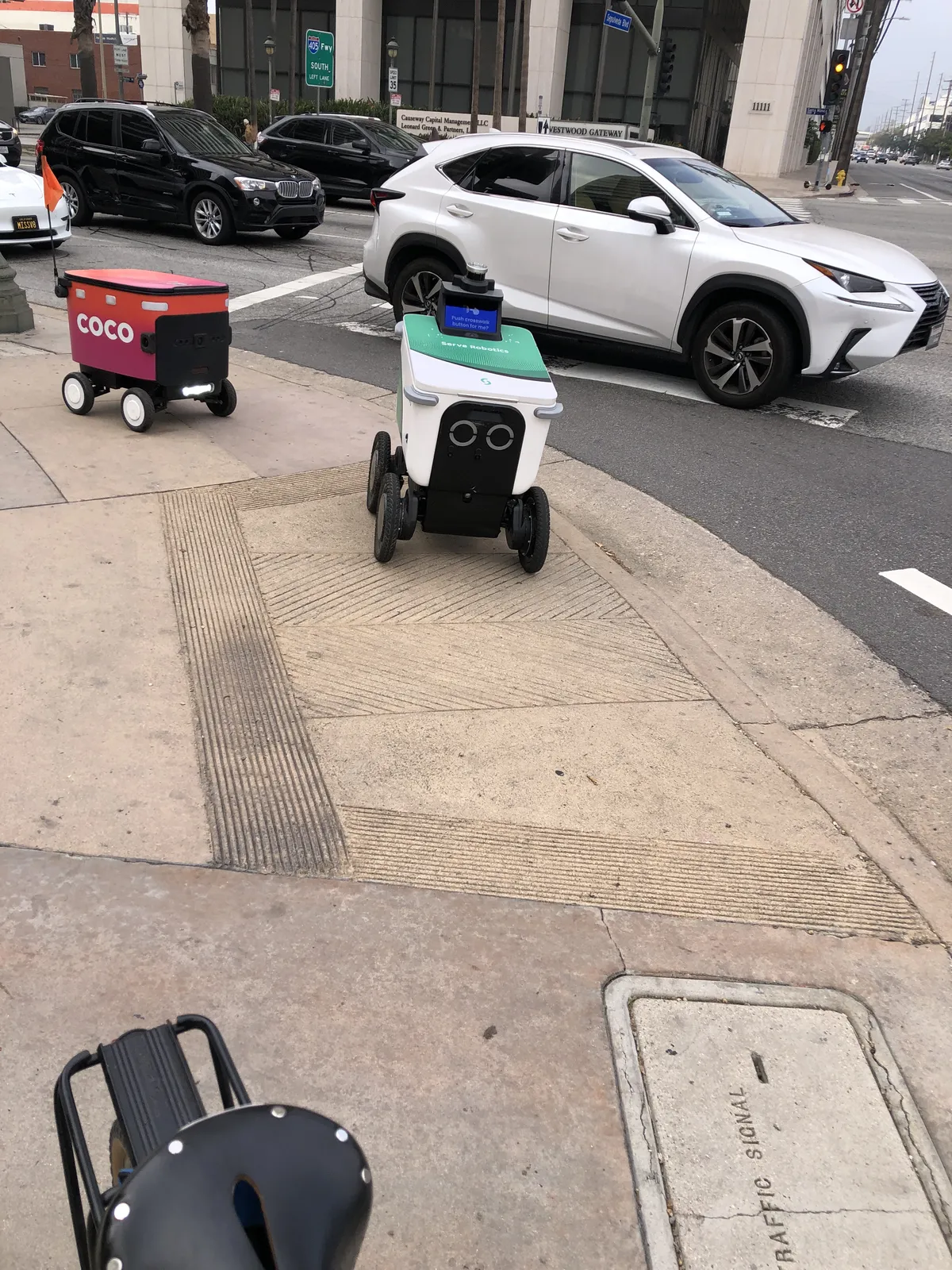18 Nov, 2025
I have spent the last few weeks living in Westwood. Near UCLA, you tend to see a lot of "delivery robots" - tiny square delivery vehicles which are ambiguously driven by people? not by people? through this part of the city to make food deliveries.
Here are some parked on the street. You will see that the one closest to the camera is also an advertisement for the TV show "Welcome To Derry."

Like a lot of companies, Coco, the company that operates most of these machines, keeps it vague on whether these robots are joysticked directly by humans, and how often, and in what circumstances. Most of the people I know believe that these "robots" are joysticked from afar, directly by humans, nearly all of the time. I can't say that's for sure, but the marketing copy on the website is evasive enough that it's possible:
End-to-End Neural Networks
Coco Robotics navigates dense urban environments by combining precision mapping, end-to-end neural networks, and human oversight. Its delivery vehicles are built to handle unpredictable terrain—like crowded sidewalks, uneven surfaces, and low-light conditions—common in cities like Los Angeles. With onboard cameras, LiDAR, and GPS, Coco’s robots can safely maneuver through complex pathways, delivering goods quickly and reliably while adapting to ever-changing street-level dynamics.
Later on, it implies that human intervention is needed infrequently, without really ever saying for sure how frequently or infrequently it's needed.
When human intervention is needed, the Pilot Terminal instantly delivers all relevant context—ETA, turn-by-turn navigation, obstruction alerts, a troubleshooting guide, and map annotation tools—for fast, informed decision-making.
This kind of marketing language should be pretty familiar to you by now. It's the kind of language that very carefully avoids saying exactly what contribution humans are making, probably so that - if you desire - you can imagine that these robots are more autonomous than they really are. (Waymo has the same problem - those "self-driving" cars also have pretty heavy "human oversight.")
I am personally leaning towards "nearly continuously joysticked." They tend to navigate moving obstacles - humans, strollers, dogs, etc - in an aware, hesitant, almost social way that suggests to me there's a human consciousness "in" there, choosing how to share space with me on the sidewalk. I suppose it's possible that they drive themselves autonomously when no moving obstacles like humans are around, but in the places I see them most often, human interaction can be very nearly continuous. So I see these things nearly continuously negotiating with me for space on the sidewalk. In the presence of humans, they don't seem to have interpretable, manipulable heuristics of movement, or repeated habits, or anything that marks their movement as particularly "autonomous". They're just kind of navigating around me, differently every time, the way a person might roll an RC car around me.
But: this is just my guess. I have no proof to back up my belief that the ones I see around me in 2025 are continuously joysticked. There's something very interesting in the way the company's evasiveness about human oversight allows everyone who encounters these things to fill in the unexplained space with their own techno-optimism or cynicism. I'm certainly a cynic.
A few years ago, they were less evasive. This article from June 2023 says that they were human-driven at that time, and that the company had engineers trying to make them autonomous.
Human drivers are part of the Coco business model. Employees working from home pilot them through dense urban areas remotely, using Xbox controllers.
“We like people who are good at video games,” Rash said. “So our interview is a video game, we do training in simulators and video games. So it’s a lot of young gamers, and that’s a great demographic to tap into.”
A second company has somewhat larger and more expensive-looking delivery boxes in the neighborhood as well - Serve Robotics. These are more anthropomorphized, and they have a little screen on top which states their "name." This company's stance toward autonomy is even fuzzier - they say even fewer specific things - but their site links to a completely different site for a Swedish "teleoperation" company. So I feel even more confident in believing that these are joysticked.
Fundamentally, the streetscape is made for cars, and then for humans. Joysticked or autonomous boxes on the street are in a distant third. They are not able to interact with beg buttons at crosswalks. A few weeks ago, I had a strange encounter with one that actually "noticed" me, did a k-turn to face me, then "asked" me to press the crosswalk button for it:


That's a little screen saying "Push crosswalk button for me?"
I pushed it. The only reason I did is because I was so certain that a real human somewhere - someone with an absolutely abysmal teleoperation job delivering snacks to American college students in a tiny rolling box - needed me to make their day easier. If I believed it was an autonomous robot operated by a tech company, I think I would have tried to find a way to leave it completely fucking stranded.
.png)




